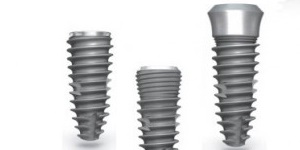
بررسی ایمپلنت های دندانی و مزیت آن ها
2015-12-26
اباتمنت های طبیعی ترانزیشنال
2015-12-26Teeth restored with dental implants look, feel and function just like natural teeth. You brush, floss and visit your dentist for regular check-ups and cleanings, same as you would to care for a natural tooth
After meeting with a dental implant dentist to develop your treatment plan, the placement of a dental implant usually involves several steps
The dental implant, usually a cylindrical and/or tapered post made of titanium, is placed surgically into the jawbone
As you heal, your implant will osseointegrate, or fuse with, your natural jawbone, with the two growing together to form a strong and long-lasting foundation for your replacement teeth. This healing process can take weeks to months while you proceed with your everyday life in between appointments
Once the implant bonds with the jawbone, a small connector – called an abutment – is placed on top of the dental implant to connect the implant to the replacement tooth or teeth
An individual tooth, an implant-supported bridge or dentures containing multiple teeth are then attached to the abutment
What are the benefits of dental implants over other treatments
Why are dental implants often the first choice and a standard of care compared to other options to restore missing or damaged teeth
Next best thing to healthy, natural teeth. Strong and stable, a dental implant restores a lost tooth so that it looks, feels, fits and functions like a natural tooth. Other options can lead to bone deterioration, and may interfere with eating, smiling, speaking and other activities of everyday life
Built to last. Dental implants are a long-term solution. Traditional, tooth-supported dental bridges only last five to seven years, and with proper care often more than 10 years, but at some point they may need to be replaced. While dental implants may need periodic adjustments, they can last a lifetime when properly placed and cared for over time
Enjoy life without worrying about your teeth! No need to stay home or feel uncomfortable in public, embarrassed because your smile looks different, or worrying that missing teeth will limit your ability to join in the fun or that removable dentures or tooth-supported replacement teeth will loosen or fall out when you talk, eat or laugh. Teeth restored with dental implants are teeth that let you, not your teeth, lead your life
Retain your natural face shape, and smile. A face without teeth can sag and appear sunken and sad. Dental implants allow you to maintain the natural shape of your face and smile
Protect healthy bone. Leaving empty spaces in your mouth after losing one or more teeth can lead to additional health issues, such as the loss and deterioration of some of your jawbone. When it is not being used to support a natural tooth, the jawbone deteriorates, losing its strength and firmness. Dental implants are the only dental restoration option that preserves and stimulates natural bone, actually helping to stimulate bone growth and prevent bone loss
Keep your teeth in your mouth – not in a cup. Dental implants allow you to keep your teeth where they belong – in your mouth. And no more worrying that your dentures might slip or fall out. Brush, floss and care for teeth that have been replaced using dental implants exactly the way you would natural teeth – in your mouth
Speak easy. Adjusting to removable dentures can mean struggling to pronounce everyday words. Not so with dental implants, which function like natural teeth
Eat your favorite foods! Taste and enjoy the foods you love without hesitation. You can bite naturally, eat virtually anything you want and, unlike removable dentures that can feel uncomfortable, you can experience the full taste of the food you eat with dental implants, too
Look Mom, no cavities! Cavities can’t occur in an implant-restored crown, or replacement tooth; however, you will need to visit your dentist as scheduled and clean and care for it and your gums and mouth every day, the same as you would if it were a natural tooth
Keep teeth in place – silently. Dentures may slip when you eat, talk, smile, laugh, kiss, yawn or cough, so that you have to “reposition” them back into place in the mouth. Dental implants are fixed in place and fuse naturally with your jawbone, meaning your replacement teeth won’t move, click or shift
Protect your healthy teeth. Placing a tooth-supported bridge requires grinding away the teeth on one or both sides of the missing tooth or teeth – thereby damaging healthy teeth to restore those that are missing. The modified healthy teeth are attached to, and support, the bridge. Dental implants go in the jawbone, in the spot where your missing tooth root was, without impacting healthy teeth. They also help prevent healthy, adjacent teeth from shifting as they would if an empty space were left for an extended period of time
More predictable than other repair and restoration methods. Dental implant treatment has a track record of reliable, long-term successful outcomes and is often considered “more predictable” than other treatments to repair or replace missing teeth, including bridgework, removable appliances and retreatment of failing root canal (endodontic) therapy
reference
related content






